The Checker Maven
The World's Most Widely Read Checkers and Draughts Publication
Bob Newell, Editor-in-Chief
Published each Saturday morning in Honolulu, Hawai`i
Contests in Progress:
Three Easy Strokes, Part Two
We continue again this month with our "summer light" series of easier-than-usual stroke problems with this offering for June, which is, as you will see if you figure it out, a bit mis-labeled. And be forewarned, after this series concludes it's back to the hard ones!
After you solve it click on Read More to check your answer.
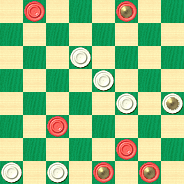
WHITE
White to Play and Win
It's Easy When You Know How
A recent addition to the library in our Santa Fe office is an item we've sought for quite some while: W.T. Call's Midget Problems, published in 1913. We think the following quotation from the preface to this little booklet is revealing:
'Are not these little problems easy?
'Yes, when you are looking at the solutions.'
Over the coming months we'll be featuring some selections from this work, which features nothing but problems with two pieces per side, hence the title, Midget Problems. But as the preface warns, these are small only in size, not in challenge.
We'd like to start out with an offering that you might consider trite; and frankly, we'd have to agree, yet there is a method to our madness. It is a setting of First Position, credited to Dr. T. J. Brown of Limerick, who put this forth around the year 1870.

BLACK
Black to Play and Win
And when you've worked through this setting (you can click here for an animation of Dr. Brown's trunk solution), answer this trivia question, also credited to Dr. T. J. Brown. What is the earliest published example of First Position? Can you name the author and year? If you can, you really know your draughts history.
But before you're done, tell us, if you can, what White's last move might have been, and then draw a conclusion from your answer. (Thanks go to Brian Hinkle for this one.)
As usual, click on Read More for the answers.
[Read More]A Tommie Wiswell Saturday Bonus!
As a special Saturday extra for our readers, we offer this Tommie Wiswell Prize Problem, which is actually somewhat easier than most Wiswell offerings, but certainly no less elegant.
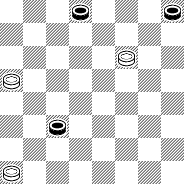
WHITE
White to Play and Draw
Rush Hour

Click on Read More to check your solutions.
(We are always in need of speed problems. If you have any that you'd like us to publish, please contact us using the contact link in the left column. We are looking for problems that are much harder than the ones we've been publishing but still easy enough for an experienced player to solve in under five minutes.)
Problem No. 1. Very easy.
Problem No. 2. Easy.
[Read More]Who's Number One?



After today's play (27 May 2005) Alex is leading Ron 5 to 2 with 13 draws. This is spirited, fighting checkers - how often do we see 7 out of 20 grandmaster games end in a victory? But no matter who finally emerges from this battle as the present-day Number One, we're seeing checkers at its very best.
(Editor's note, 01 June 2005: Alex wins the match with a score of 8 wins, 3 losses, and 25 draws!)
Right now, though, we want to take you back to an earlier contest for the claim to the title of Number One, a match held in the U.K. in 1958 between the American great Marion Tinsley and the British grandmaster Derek Oldbury. Tinsley walked out the undisputed world champion with nine wins, one loss, and 24 draws. Despite the seemingly uneven score, the match was hotly contested and produced some very fine play.



Here's a position from the very first game of the match:
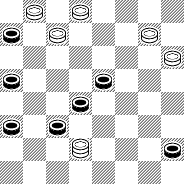
BLACK (Tinsley)
Black to Play and Draw
Now let's leap ahead to Game Seven. Here's the situation:
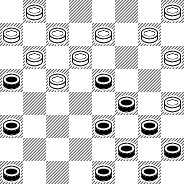
BLACK (Oldbury)
Black to Play and Draw
Click on Read More to see how your play stacks up.
[Read More]A Not-So-Mysterious Stranger
The May installment of our ongoing "Masked Man" series will give our readers a bit of a reprieve, and a chance to perhaps actually guess the identity of our featured problemist.

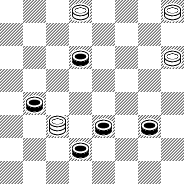
BLACK
Black to Play and Draw
Check your solutions by clicking on Read More.
[Read More]A Prize Problem - Well, Kind Of
A little while back we came into possession of a number of 1950-era issues of California Checker Chatter (CCC). The checker scene in California certainly seemed to be active in those days; the magazine talks of clubs in Oakland, Santa Monica, and other places around the state.
Out of those yellowing but fascinating pages from the past we've chosen our topic for today: the CCC "Prize Problem" for November, 1948. But, subsequent to publication, the "star" line was found to be faulty, and the problem flawed.
The original premise was this.
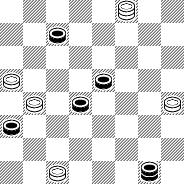
WHITE
White to Play and Win
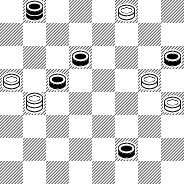
BLACK
Black to Play and Draw
Click on Read More to check your solution. [Read More]
Three Easy Strokes: Part One
Our title, predictably, doesn't refer to an easy par-three golf hole, but to our desire to present a short series of stroke problems that, frankly, aren't quite as difficult as some of our earlier offerings.
Try your hand at this first one and decide for yourself if it's a spring breeze; then click on Read More for the solution.
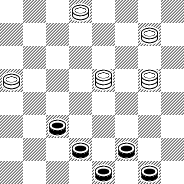
BLACK
Black to Move and Win
Minority Rules
We're really pleased to present this stunning Tom Wiswell problem. As usual, it is not easy, but it is elegant, entertaining, and instructive, and illustrates the depth and scope of our game of checkers. The setting is below; we think this is among the finest problems we've put forth to date.
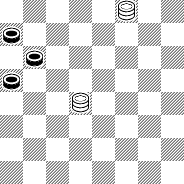
WHITE
White to Play and Win
Solve it if you can, and then click on Read More for the surprising solution.
[Read More]Two Easy Pieces, Fourth Installment
As we continue our electronic republication of Willie Ryan's classic Tricks Traps & Shots of the Checkerboard we wish to thank those readers who pointed out typos in the original book. We also recognize there are some readers (your editor at times among them) who don't think these pieces are all that easy! But we'll let Willie carry on.
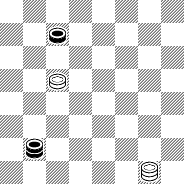
White to Play and Draw
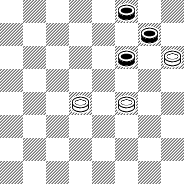
Black to Play and Draw
The Checker Maven is produced at editorial offices in Honolulu, Hawai`i, as a completely non-commercial public service from which no profit is obtained or sought. Original material is Copyright © 2004-2024 Avi Gobbler Publishing. Other material is the property of the respective owners. Information presented on this site is offered as-is, at no cost, and bears no express or implied warranty as to accuracy or usability. You agree that you use such information entirely at your own risk. No liabilities of any kind under any legal theory whatsoever are accepted. The Checker Maven is dedicated to the memory of Mr. Bob Newell, Sr.

